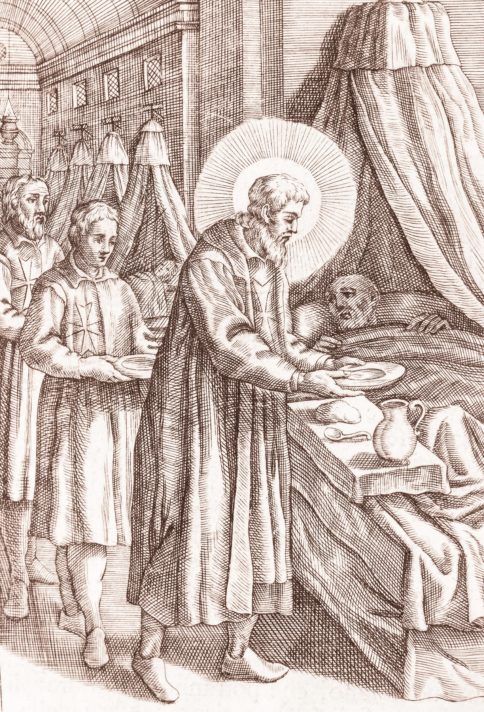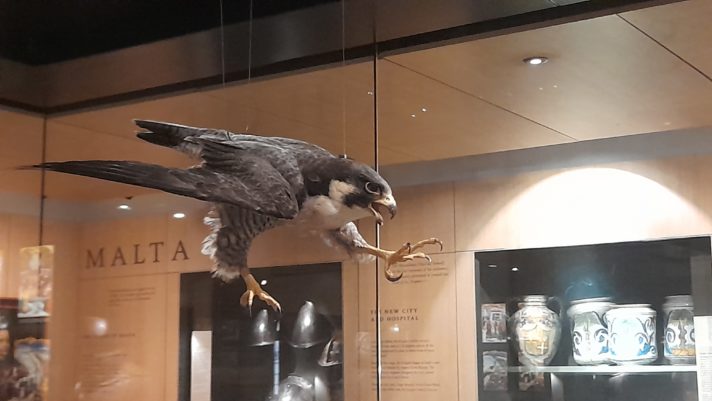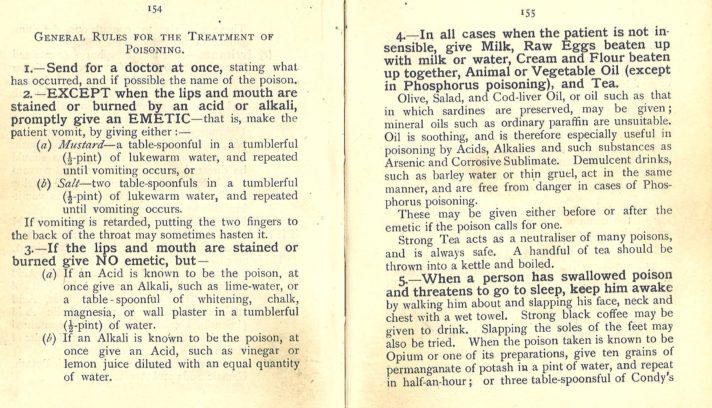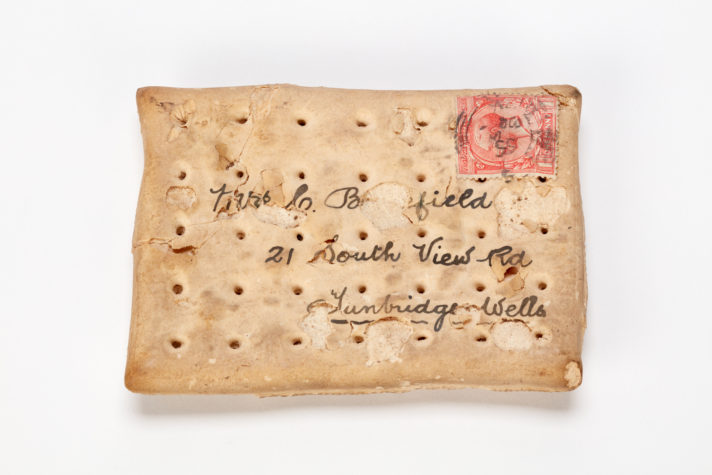Food has always been a fundamental part of human history and culture, and this is no different for the Order of St John. In the Order’s first hospital in Jerusalem the diet of the patients was given as much attention as their medical care. In the 2nd century the Greek physician Galen advocated that food was a fundamental part of treating the sick; his influence was strongly felt in Western medical practice well into the Middle Ages and was a tentpole of Order practice. As the Order’s physicians grew in experience and confidence they would develop on Galen’s original ideas and benefit from contemporary medical developments to better care for their patients; considering Galen thought quails gave you epilepsy and that wounds should be dressed in red wine, oils, eggs and turpentine, the Order’s adaptations to his approach were likely welcomed by their patients.
The original Order hospital in Jerusalem had two kitchens, one which focused on providing standard meals for both male and female patients, the other dedicated to preparing meals for patients who had digestion problems. White bread and meat, both very uncommon diet staples in that era, were served to patients at least three days a week, in addition to a varied range of fruits and vegetables. When white bread was not available patients ate rye bread or cornbread, and the meats available included pork, mutton and lamb, chicken, doves, and partridges. Patients were also regularly served wine.

There were some exceptions to the menu in the hospital, which were due to medical reasons: these included the flesh of breeding sows, shrimp, moray eels, beans, and lentils, although chickpeas were permissible. It was a rule of the hospital that patients should only eat the meals provided and not consume anything brought by outsiders in case it conflicted with their prescribed diet – this was taken so seriously that patients’ beds were searched twice a day to seek out any illicit snacks!
This approach to patient diet did not change significantly throughout the centuries, the Order’s hospitals maintaining a varied and healthy menu. In a 1676 text, The Old and New Statutes of the Order of St. John of Jerusalem, it is written that “The Director of the Infirmary shall take care to give the sick none but the best and most delicate sorts of foods, as pullets and chicken, good bread and good wine to supply them with good nourishment.” Regular meals with a variety of meats, fish, grains, and vegetables continued; at one time it is recorded that two hundred chickens a day were used in the hospital just for making the soup for the patients.
This comprehensive and luxurious attitude towards catering is visible in records of the Order even as it moved to Rhodes and then to Malta. In those first centuries of the Order the Knights used bread trenchers rather than metal plates to hold their meals. The bread was made of barley, unleavened and stretched out to six inches long by two inches wide. A person called a ‘Pantler’ made these special bread trenchers, and they were often left for two to four days to sufficiently harden them for use. When the Knights had eaten their meals their trenchers of bread, with the juices from the meat soaked into them, were given to the poor. In the 17th century, as metal, wood, pewter, and silver became more popular and feasible for use as tableware, trenchers were adapted to meet new requirements. Small pieces of toasted bread were put in dishes to soak up the sauces and, to avoid marking softer metals like pewter and silver with cutlery, the bread trenchers were put onto the plates as a protection. The Grand Master and the Grand Crosses, the most senior Order members, were given four trenchers, three in a triangle and the fourth placed on top. The expression ‘upper crust’, denoting a social superior, originates from this period – the Grand Master or Lord was always given the upper crust.
As well as being used as a tool for care of the sick in its hospitals and sustenance for its members, the Order also used food as a fundamental part of its wider culture of hospitality: as far back as 1338 we can find in their accounts expenditure sheets which contain multiple references to the associated costs of hosting visitors. At large dinners hosted by the Order the food was part of the decoration, laid out in ways that demonstrated religious teachings or allegorical stories most befitting the purpose of the gathering, foods even being coloured with woodchips or brightly-coloured spices for visual effect rather than for taste. Food was also a vital part of demonstrating wealth and abundance; in 1775, to celebrate the election of Grand Master Rohan, it is recorded that the fountains ran with wine, an offering of calves, sheep, pigs, ducks and pigeons presented by the Grand Master’s faithful vassals was shared with the Hospital and Cathedral, the Pagery were given 12 bowls of confections, and one small boy who recited a poem in praise of Grand Master Rohan was given a whole calf to himself. Bread was even given as part of the Order’s pension to the needy of Malta at one time during their residence on the island.
The Order’s relocation to Malta is itself inextricably tied up with food; King Charles V of the Holy Roman Empire granted the islands of Malta, Gozo, and Tripoli to the Order in 1530, even supplying corn to them free of duty. In return Grand Master de L’Isle-Adam and the Order Council agreed to a token tribute of one falcon each year, given on All Saint’s Day. The Order’s Falconer had the important dual responsibilities of obtaining game for the Grand Master’s table, as well as tending each year to several falcons, one of which would be presented as their ‘rent’ to King Charles V.

This payment was referred to as a ‘peppercorn rent’, which today means a small amount but in the medieval period pepper was valuable enough to be considered a currency in itself, and a pound of pepper was equal to several weeks of hard labour.
It is believed that Napoleon uttered the famous line ‘An army marches on its stomach’ and this is particularly evident in one manuscript in our collection. A letter written in 1648 from Grand Master Lascaris to Henri de Merles, then Grand Prior of Toulouse and Ambassador of the Order to Pope Innocent X, included instructions for the Order’s fleet to travel to Sicily, plus a beseeching note to pass on to the Pope regarding the urgent need to have more biscuits made for the squadron, even pointing out where significant supplies of wheat could be found for the purpose.
Given the long history of food’s role with the Order of St John it is unsurprising that it also features in the first aid instruction given by St John Ambulance, from its inception in the late 19th century right through to today. A section from the 1923 First Aid to the Injured manual on poisonings addresses not only where food itself can poison people, but also where food can be used to alleviate the side-effects of poisoning. It reads:
In all cases when the patient is not insensible, give Milk, Raw Eggs, beaten up with milk or water, Cream and Flour beaten up together, Animal or Vegetable Oil (except in Phosphorus poisoning), and Tea. Olive, Salad and Cod-liver Oil, or oil such as that in which sardines are preserved, may be given; mineral oils such as ordinary paraffin are unsuitable. Oil is soothing, and is therefore especially useful in poisoning by Acids, Alkalies and such substances as Arsenic or Corrosive Sublimate…Strong Tea acts as a neutraliser of many poisons, and is always safe. A handful of tea should be thrown into a kettle and boiled.

Johann Friedrich Esmarch, an early champion of first aid, in his lectures would advocate for the importance of making sure patients were kept hydrated, given nutritious sustenance and, where appropriate, how to make sure inappropriate food or drink was ejected from them. While not all of Esmarch’s advice would be medically recommended today – his advice for treating patients who had been drowning was to, once roused, feed them spoonfuls of warm liquids such as tea, coffee, brandy and water, or wine – today’s first aid manuals still focus on food-related ailments and treatments, such as recognising food poisoning and the importance of sugary foods for those with type one diabetes.
I will end this blog with the history of my favourite food-related object in the Museum of the Order of St John’s collection. Much as the Order and St John Ambulance recognised the importance of food in medical care, the necessity of sufficient food during wartime, both at home and on the front, was keenly recognised by the British Armed Forces in the First World War. With resources scarce the focus was less on how to give soldiers a varied, nutritious diet and more on how to give them as many calories in as small a ration as possible. It was this attitude which gave rise to the biscuit staple of the ration allowance. Unlike the biscuits we have available today for this talk, these biscuits were made from wholewheat flour, no sugar and were so hard they regularly damaged the teeth of soldiers who had not taken the precaution of dunking them into hot water or tea first. Enterprising soldiers soon found an alternative use for this unpalatable snack and fashioned them into picture frames, canvases and even postcards; one such missive was sent by soldier Henry Charles Barefield to his home in Tunbridge Wells with the message “Our new rations. Thought you would like one.” Not only was this biscuit hard-wearing enough to travel from France to England, but it is also still in one piece and on display in our St John Ambulance Gallery!



